![]()
![]()
![]()
Use LEFT and RIGHT arrow keys to navigate between flashcards;
Use UP and DOWN arrow keys to flip the card;
H to show hint;
A reads text to speech;
20 Cards in this Set
- Front
- Back
|
Blank
|
Blank
|
|
|
Review the grouping of lipids
|
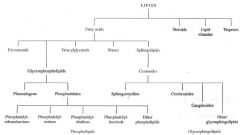
|
|
|
Discuss the biomedical importance of fatty acids
|
Obesity, CV disease, Barth Syndrom, Lipidoses, Congenital generalised lipodystrophy
|
|
|
Discuss the biological importance of dietary essential fatty acids.
|
Essential fatty acids are members of either the ω-6 or ω-3 families. Functions include membrane structure, specific enzyme/protein interactions within membranes and synthesis of eiconosoids. Required for synthesis of arachidonic acid and docosahexanoic acide synthesis.
|
|
|
Describe in detail the structure and importance of linoleic and alpha-linolenic acid
|
Essential Fatty Acids
Linoleic Acid - 18:2 Δ9, 12, ω-6 fatty acid Alpha-Linolenic Acid - 18:3 Δ9, 12, 15, ω-3 fatty acid |
|
|
List Important long-chain fatty acids and their structures.
|
Palmitic (end product of mammalian fatty-acid synthesis) - 16:0
Stearic acid: 18:0 Oleic Acid: 18:1 Δ9, ω-9 Linoleic Acid: 18:2 Δ9, 12, ω-6 Alpha-Linolenic Acid - 18:3 Δ9, 12, 15, ω-3 Arachidonic Acid - 20:4 Δ5, 8, 11, 14 ω-6 |
|
|
Discuss the grouping of fatty acids into the ω-6, ω-3 families.
|
The human body cannot synthesize n−3 fatty acids de novo, but it can form "long chain" 20-carbon n−3 fatty acids (like EPA) and 22-carbon n−3 fatty acids (like DHA) from the "short chain" eighteen-carbon n−3 fatty acid α-linolenic acid.
These conversions occur competitively with n−6 fatty acids, which are essential closely related chemical analogues that are derived from linoleic acid. Synthesis of the longer n−3 fatty acids from linolenic acid within the body is competitively slowed by the n−6 analogues. Thus accumulation of long-chain n−3 fatty acids in tissues is more effective when they are obtained directly from food or when competing amounts of n−6 analogs do not greatly exceed the amounts of n−3. |
|
|
Describe in general the synthesis of arachidonic acid, docosahexaenoic acid (DHA) & eicosapentenoic acid (EPA)
|
Omega 6:
Dietary source → Linoleic C18:2n-6 → γ-Linolenic C18:3n-6 → C20:3n-6 → Archidonic C20:4n-6 →C22:5n-6 Omega 3: Dietary source → α-Linolenic C18:3n-3 → C18:4n-3 → C20:4n-3 → Econsapentaenoic (EPA) C20:5n-3 → Docosahexonoic (DHA) C22:6n-3 |
|
|
Describe the structure of Acyglycerols.
|

Acylglycerols are made of glycerol and at least one fatty acid (acyl chain). They are refered to as mono-, di- or tri- (MAG, DAG, TAG) depending on the number of acyl chains esterified to the sugar moiety.
|
|
|
Define Diphosphatidylclycerol (Cardiolipin). Describe one pathology linked to it.
|

Diphosphatidylglycerol (cardiolipin) - Two phosphatidylglycerols connect with the glycerol backbone in the center to form a dimeric structure.
Essential for the optimal function of numerous enzymes that are involved in mitochondrial energy metabolism. Barth's Syndrome - A mutation of its synthesizing enzyme causes a deficit and therefore abnormal mitochondria and a sharp decline in ATP production. Cardiomyopathy and general weakness are common. Cardiolipin treats the symptoms and prevents infection. |
|
|
Distinguish between Phospholipids and Glycolipids, two types of Acylglycerols - PHOSPHOLIPIDS
|
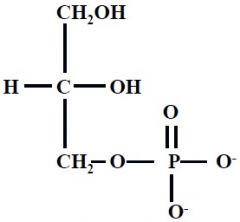
PHOSPHOLIPIDS - Also known as phosphoacylglycerols/ phosphoglycerides. One of the alcohol groups is esterified to a phosphoric acid moiety.
|
|
|
Define Sphingolipids. Are they phospholipids? How do they differ?
|

Sphingophosphospholipids are structural analogs of phospholipids, in which sphingosine (long chain aminoalcohol) replaces the glycerol backbone. They have a ceramide backbone with an amino alcohol sphingosine moeity in an amide linkage.
|
|
|
Distinguish between Phospholipids and Glycolipids, two types of Acylglycerols - GLYCOLIPIDS
|
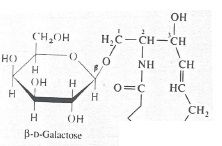
One of the alcohol groups is esterified to a sugar moiety. Their role is to serve as markers for cellular recognition on membranes.
Myelin - lipid rich membrane sheath for axons. High sphingomyelin:protein ration. Insulatory effect promotes rapid transmission. Multiple Sclerosis - myelin sheaths deteriorate to scleroses (hardened plaques) which leads to slowing and cessation of nerve transmission. It is a possible viral infection that precipitates an autoimmune response |
|
|
Define Phosphatidylcholine and Phosphatidylethanolamine. How is their function related to their differing from other phospholipids? How do Phosphatidylserine and Phosphatidylinositol differ?
|
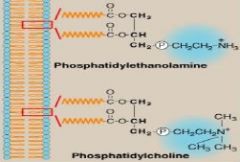
Phosphatidylcholines (PtdCho) are a class of phospholipids where one of the alchohols has been esterified by a choline moeity.
Phosphatidylethanolamine (PtdEth) are a class of phospholipids where one of the alchohols has been esterified by an ethanolamine moeity. With a net zero charge, and no kinks, they are able to pack tightly and are a major component of biological membranes. Phosphatidylserine replaces an alchohol with a serine group and has a negative charge. Phosphatidylinositol replaces it with a inositol group and can be phosphorylated. |
|
|
Define plasmalogens. How does it differ from other phospholipids?
|
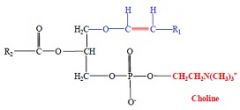
Plasmalogens are phospholipids where the hydrocarbon chain is linked with an ether rather than an ester.
|
|
|
Define Sphingomyelin. How does it differ from a standard sphingolipid? What two pathologies are related to it?
|
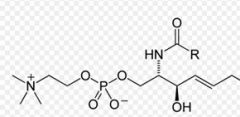
One of the alcohols on the ceramide backbone is phosphorylated with a choline moeity.
The most common sphingolipids, it is a major component in myelin sheaths, the lipid-rich membrane sheath for axons. Multiple Sclerosis - A crippling and fatal disease where myelin sheaths deteriorate to scleroses (hardened plaques in multiple regions). Loss of myelin leads to slowing and cessation of nerve transmission. Possible viral infection that precipitates an autoimmune response Niemann-Pick disease - An example of a lipid lysosomal disease, also known as a lipidosis. In the absence of sphingomyelinase, sphingomelin accumulates in lysosomes causing enlarged liver and spleen filled with lipid, severe mental retardationa nd neurodegeneration, death in early childhood. |
|
|
Define Cerebrosides. What makes them glycolipids? Where are they found?
|

Cerebrosides are the simplest and most common of the sphingoglycolipids. Though they have a ceramide backbone, they possess one sugar moeity, making them glycolipids
The most prevalent are Galactocerebrosides, located in neuronal cell membranes of the brain and have a galactose head group. |
|
|
Define Gangliosides. What is their structure and and what pathology is linked to them?
|
Gangliosides form the most complex of the sphingolipids and have at least one sialic acid residue among their sugar groups. They are specific determinants of cell-cell recognition in CNS gray matter and may have an important role in the growth and differentiation of tissues as well as carcinogenesis.
Tay-Sachs Disease - The disease occurs when harmful quantities of gangliosides accumulate in the nerve cells of the brain, eventually leading to the premature death of those cells. |
|
|
Define Dipalmitoylphosphatidylcholine and its structure. What does it have to do with Respiratory Distress Syndrome?
|
Dipalmitoylphosphatidylcholine is a Phosphotidylcholine with two palmitic acids esterified to the glycerol backbone. It is virtually the sole component of lung surfactant, which lowers alveolar surface tension, preventing lung collapse. It replaces sphingomyelin in amniotic fluid immediately before birth indicating lung maturity.
C-Sections reduce cortisol secretion (stress hormone) which is involved in stimulating surfactant producing cells. This is vital with premature babies. |
|
|
Describe the structure and biolmedical importance of cholesterol
|
Sterols are synthesized from 5-carbon isoprenoid units. It is the most abundant steroid in animals. If it's R1 group is an -OH, it is a sterol. If it is anything else, it is a steroid.
Cholesterol is amphipathic due to the -OH. It is essential for membrane fluidity and steroid hormone and bile acid synthesis. It is generated in the liver. |

